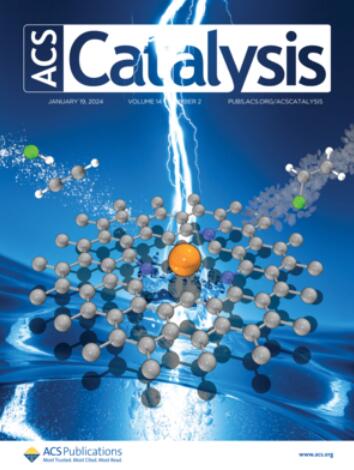纳他唑生物合成中一种KAS iii类酶和一种氨基水解酶
IF 11.3
1区 化学
Q1 CHEMISTRY, PHYSICAL
引用次数: 0
摘要
苯并恶唑是一种重要的杂环化合物,常见于药用化合物和天然生物碱中。破解苯并恶唑的生物合成机制有助于苯并恶唑类药物的高效合成。纳他唑是一种独特的生物碱类,含有两个苯并恶唑片段(a和B)。先前的研究已经建立了苯并恶唑片段a(两个3-羟基苯甲酸分子融合)生物合成的酶促机制。在这里,我们报告了纳他唑的相同生物合成机制采用不同的逻辑,其中涉及3-氧酰基- acp合成酶iii样酶(NatS),以组装苯并恶唑部分B(3-羟基苯甲酸与6-甲基水杨酸融合)。生化和结构表征表明,NatS催化转酰化反应生成不稳定的酯中间体,该中间体立即被氨基水解酶NatAM催化环化和脱水,得到苯并恶唑片段b。有趣的是,NatS还能催化C-N和C-S键形成,并表现出显著的底物乱交性。启发我们按照b片段的组装逻辑合成各种苯并杂环。结合我们对纳他唑类似物A33853的生物合成的研究,我们进一步确定了两个负责NatAM底物识别的关键氨基酸,从而在纳他唑中生成两个苯并恶唑片段。最后,我们成功地开发了一种化学酶法生产转甲状腺素稳定剂Tafamidis (Vyndamax)。因此,我们的研究发现了苯并恶唑生物合成之谜的缺失部分,为创造不同类型的苯并杂环化合物提供了一种有希望的策略。本文章由计算机程序翻译,如有差异,请以英文原文为准。

A KAS III-like Enzyme and an Amidohydrolase in Nataxazole Biosynthesis Direct Formation of the Benzoheterocycle Moiety
Benzoxazole is an important heterocycle building block frequently found in medicinal compounds and naturally occurring alkaloids. Deciphering the biosynthetic machinery of benzoxazole would facilitate the efficient synthesis of benzoxazole-based drugs. Nataxazole represents a unique alkaloid class containing two benzoxazole moieties (A and B). Previous studies have established the enzymatic mechanism underlying the biosynthesis of benzoxazole moiety A (fusion of two 3-hydroxyanthranilic acid molecules). Here, we report that the same biosynthetic machinery of nataxazole employs a different logic, which involves a 3-oxoacyl-ACP synthase III-like enzyme (NatS), to assemble benzoxazole moiety B (fusion of 3-hydroxyanthranilic acid with 6-methylsalicylic acid). Biochemical and structural characterization indicated that NatS catalyzes a transacylation reaction to generate an unstable ester intermediate, which immediately undergoes cyclization and dehydration catalyzed by the amidohydrolase NatAM to give benzoxazole moiety B. Interestingly, NatS can also catalyze C–N and C–S bond formation and exhibits remarkable substrate promiscuity, inspiring us to synthesize various benzoheterocycles following the assembly logic of moiety B. Together with our investigation into the biosynthesis of nataxazole analogue A33853, we further identified two key amino acids responsible for NatAM’s substrate recognition to generate two benzoxazole moieties in nataxazole. Finally, we successfully developed a chemoenzymatic approach to produce transthyretin stabilizer Tafamidis (Vyndamax). Therefore, our study found the missing piece of the benzoxazole biosynthesis puzzle, providing a promising strategy to create diverse types of benzoheterocycle compounds.
求助全文
通过发布文献求助,成功后即可免费获取论文全文。
去求助
来源期刊

ACS Catalysis
CHEMISTRY, PHYSICAL-
CiteScore
20.80
自引率
6.20%
发文量
1253
审稿时长
1.5 months
期刊介绍:
ACS Catalysis is an esteemed journal that publishes original research in the fields of heterogeneous catalysis, molecular catalysis, and biocatalysis. It offers broad coverage across diverse areas such as life sciences, organometallics and synthesis, photochemistry and electrochemistry, drug discovery and synthesis, materials science, environmental protection, polymer discovery and synthesis, and energy and fuels.
The scope of the journal is to showcase innovative work in various aspects of catalysis. This includes new reactions and novel synthetic approaches utilizing known catalysts, the discovery or modification of new catalysts, elucidation of catalytic mechanisms through cutting-edge investigations, practical enhancements of existing processes, as well as conceptual advances in the field. Contributions to ACS Catalysis can encompass both experimental and theoretical research focused on catalytic molecules, macromolecules, and materials that exhibit catalytic turnover.
 求助内容:
求助内容: 应助结果提醒方式:
应助结果提醒方式:


